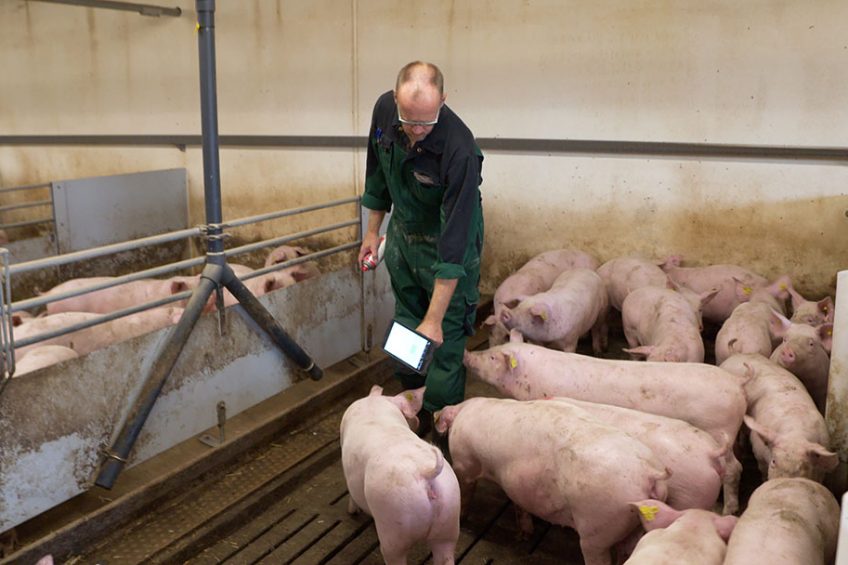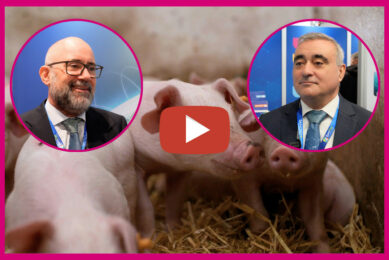Farm visit: Aiming for higher litter homogeneity

Danish swine producer Søren Kjær Poulsen has a strong focus on multiplication of Landrace pigs. With his experienced staff and a new protein strategy, he achieves top performance as well as high levels of animal health.
Søren Kjær Poulsen, located in Lunderskov, Denmark, is counted among Denmark’s most successful DanBred breeders in Denmark. With around 850 purebred sows, of which 160 are Landrace, he breeds around 26,000 piglets/year at his farm Dortheasminde. Poulsen says, “Our breeding production can be divided into roughly 2,000 gilts with pure Landrace genetics and 8,000 crossbred gilts, which we sell to Danish and German piglet rearers. On top of that there are boars for the studs.”
Roughly 10,000 mostly male animals will be finished by Poulsen himself. The remainder will be sent to different farms. He is running the farm, which also has 280 hectares of arable land, with his wife Lone and nine employees. He says, “The basis for our success has been our well-trained staff, who have learned how to perform as a team, and the shared conviction to continue to grow.”
Profile
Name: Søren Kjær Poulsen, owner (left); Marlene Svensmark, farm manager (right).
Location: Lunderskov, Denmark
Farm: Dortheasminde is a breeding farm with 850 sows, among which are 160 purebred Landrace sows. The farm also has 280ha of arable land, growing its own rapeseed and grains as raw materials for feed. The farm employs nine people permanently.
Three sites
Poulsen started up his business in the 1990s with 250 free-range sows. In 2002, Poulsen and his wife decided to construct a conventional facility for 650 sows in Lunderskov, western Denmark. In the years that followed, an insemination room was added to the Dortheasminde farm site as well as a grower facility at a second location, leading to the current size of 850 sows. In addition, a finishing site with over 3,000 places can be rented.
“Both the grower and the finisher sites are within 3 kilometres of the main facility, so it is easy to make working schedules,” Poulsen says. In order to optimise animal care, and to operate the pig houses efficiently, the employees have been given individual production areas.
Farm manager Marlene Svensmark has been working for Poulsen for almost 20 years. Focusing mostly on the day-to-day managing of the farm, she is the owners’ first point of contact inside the pig houses.

A strong team
Both have a strong network in the Danish pig industry. During work meetings as well as in Facebook or WhatsApp groups, they intensively exchange thoughts and ideas with other farm owners and pig farm managers. With a twinkle in his eyes, Poulsen says, “We may not look into each other’s bedrooms, but business-wise when we meet everything is on the table.”
A major theme in these discussions is always how to recruit and keep good farm staff. Svensmark says, “I’m proud that we have hardly any trouble finding employees and that several in our team have been working here for almost ten years.” Her boss nods, and says with a smile: “When we renovated the sow houses in 2015, our employees had to find a different job for a few months. But as soon as the sows were back on site again, all our employees returned as well.”
Apart from basic things like decent pay and sufficient holidays, Poulsen and Svensmark also attach value to a pleasant working environment in the pig house. Every day there is a team meeting, where the to-do list is discussed and evaluations made. At various times in the year, employees can attend advanced-level courses. For the employees with young children at home, the farm aims to create flexible working schemes. Svensmark says, “That’s why we are known as a good employer in the industry.”
In addition, Poulsen says that a good web presence is essential. On the farm’s website as well as its Facebook page, pictures can be viewed of, for example, a joint canteen breakfast or training. What’s more, the website also shows professional videos of the farm, such as the pig houses and drone footage from the rapeseed harvest.

Multiplication unit since 2018
Since the total revamp five years ago, the sow house has been performing well under its experienced team. So Poulsen decided to also embark on a multiplication unit. Around 2.5 years ago, Poulsen became one of the approximately 30 farms in Denmark that breed for the national breeding programme DanBred.
Multiplication definitely requires more from management than just production of piglets for commercial production. For instance, it includes an extensive documentation and evaluation analysis. Every breeding animal in the herd has its own selection index, describing its production value by the weighted genetic factors of feed utilisation, daily gain, leg condition and the number of live pigs per litter at day 5 post-farrowing.
Own breeding goals
Apart from these superior breeding goals, Poulsen defined four key goals for himself:
- Longevity: All sows will be held in large groups with ear tag–based feeding. Poulsen and Svensmark have been paying attention for years to sows having decent legwork and therefore spending a long time on-farm.
- Farm hygiene: The sow farm has an unrestricted red Specific Pathogen Free (SPF) status. Poulsen explains, “That is the highest health status given in the Danish SPF system. It means that the breeding facility is free from certain dangerous pathogens like mycoplasma as well as Porcine Reproductive and Respiratory Syndrome virus.” To maintain the status, on top of the SPF hygiene rules, he has added UV light sources at the air inlets.
- Customer focus: Poulsen and Svensmark are always available for a chat with their customers and try to comply with their customers’ wishes. That is why gilts are offered at different ages and with different vaccination statuses.
- Gut health: Poulsen says, “Apart from the correct vaccination management, we would like to build up a balanced gut flora using feed management. In that process, raw materials, feed hygiene in the liquid feeding equipment as well as the feed structure play a big role.”

With farm benchmarking and conversations with other sow breeders from his network, last summer the breeder had the feeling that – especially in the farrowing room – improvements could be made. Poulsen says, “One has to keep in mind that we work with purebred sows and not only with F1 sows.” Still, with 29.3 weaned piglets/sow/year he was not satisfied. A pre-weaning mortality of 20% was too high for him.
“At the time we had huge problems with milk provision for newborn piglets. That is why we decided to install a fully automatic milk cup system,” says Svensmark. It proved to be a step in the right direction, as with new technology and a high quality milk replacer the average weaning weight could be increased by around 700 grammes. In order to achieve that, fewer natural nurse sows were needed than was the case in the past.

Fermented seaweed
Another starting point was a novel protein strategy in sow nutrition. In October 2019 the original raw protein components sunflower and sugar beets were replaced by the feed additive EP199, made by European Protein. This protein component is designed for sows and consists of fermented seaweed and rapeseed. The breeding farm mixes the ingredient through the sow rations at 4% for gestating sows and 9% for the lactating sows. Svensmark says, “The most remarkable changes in the pig house are the improved feed intake of the lactating sows as well as the litter homogeneity. I am convinced that our sows have been giving more milk since the feed was changed.”
According to Poulsen, the pre-treatment of the protein components is essential. He says, “We profit from the positive effects of feed fermentation on the gut flora, without having to expend a lot of effort in management and technology.” The figures from the sow management system confirm both of the swine experts’ observations. Currently 32.7 piglets/sow are being weaned, and pre-weaning mortality has dropped to 14%. Poulsen is satisfied, saying, “Together with the installation of the milk cup system we could increase the average weaning weight after 28 days by 1.4kg, to 6.5kg.”
With these figures, the additional cost of the protein component of about € 30/sow/year is economically feasible.
No zinc oxide and antibiotics
In grower pigs, the farm has been using fermented products for six years. Poulsen uses the dry fermented protein EP100i based on pure rapeseed meal, that, just like the solution for sows, contains 34% crude protein and 5% lactic acid. Because of the limited proportion of antinutrient factors, the feed additive is highly digestible. That is why Poulsen aims for a ration of roughly 15% with the grower pigs, a percentage that drops gradually to about 8% as the grower phase progresses.
In addition, it is clear that there is hardly any weight difference between the groups, and the animals appear healthy. For pig producers, that is a huge advantage, not only when the breeding pigs are ready to be marketed. Since 2017 the Danish pork processor Danish Crown has banned the use of antibiotics during the breeding phase in the context of its programme to raise pigs without antibiotics (In Danish: “Opdrættet uden antibiotika” – OUA). In addition, the company has already indicated that grower pigs should not rely on the usage of zinc oxide.
For not using antibiotics and zinc oxide, Poulsen receives a premium of € 0.20 and € 0.05 respectively on top of the grower price. He says, “These limitations should not come at the expense of animal health. And with us, that is not the case, as can be seen in the mortality rate of 1.2% in the grower phase.” Should the usage of antibiotics be unavoidable with the odd individual animal, then that animal is marketed separately.
This article was first published in Germany’s agricultural trade journal SUS. It was translated and republished with the kind approval of SUS.














